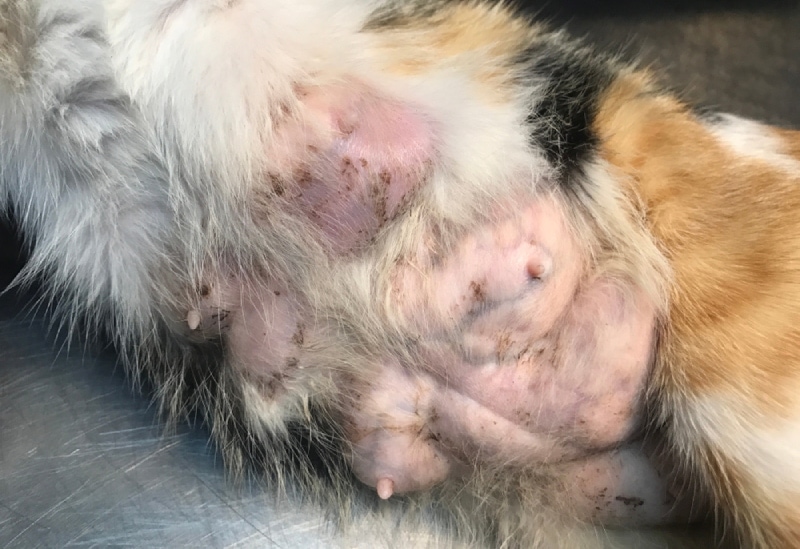Can Dogs Get Salmonella? Signs & How to Treat It (Vet Answer)

Updated on
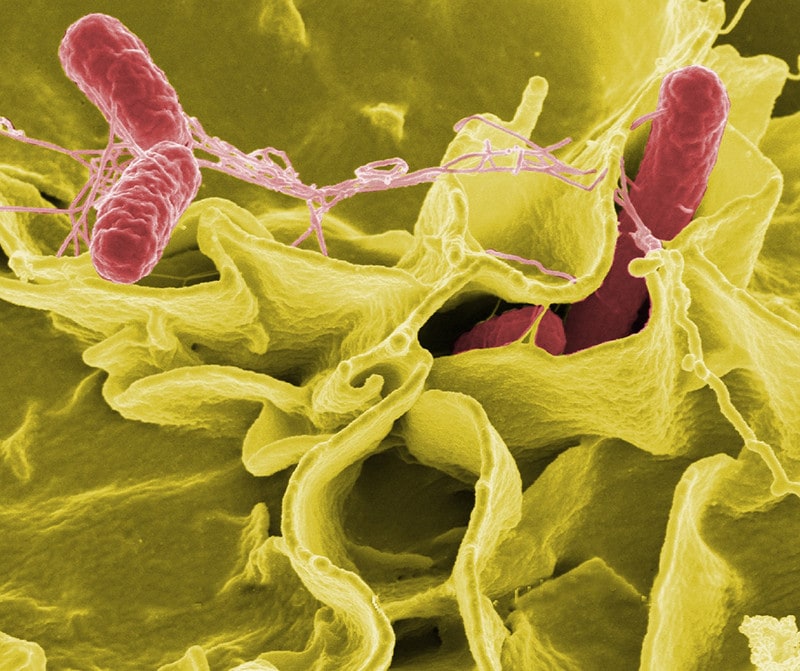
Click to Skip Ahead
The short answer to this is yes—dogs can get salmonella. Salmonella is a bacteria that mainly affects the gastrointestinal tract of animals, although it is capable of causing systemic disease as well. It can cause severe symptoms in humans. Dogs can get infected by the bacteria; however, they do not often show symptoms unless the dog has a compromised immune system or if they are young or elderly. Salmonella may be carried by dogs without any symptoms at all and clinical salmonella infection in dogs is very rare. Infection occurs by direct transmission between infected animals and infected animals and humans. It is usually spread via the orofecal route.
Dogs can pick it up from contaminated food or water supply, and the most common route of infection in dogs is thought to be by feeding raw meat.
What is Salmonella?
Salmonella is a group of gram-negative bacteria from the family Enterobacteriaceae. It is a common bacterial disease that targets the intestinal tract. The bacteria typically live in the intestines and get shed in the feces. Humans and animals usually contract the bacteria through food or water that has been contaminated with the bacteria. Clinical disease in dogs is relatively rare, especially compared to humans. Humans are much more likely to experience symptoms including fever, stomach cramps, vomiting, and diarrhea.
Humans who are otherwise healthy will usually recover fully within a few days. In some severe cases in dogs and humans, salmonella can cause dehydration that requires medical attention. Salmonella can be fatal if bacteria spread beyond the gastrointestinal tract into the bloodstream. Most salmonella species are host specific, which means that certain strains will only make certain species ill.
Unfortunately, even if a dog is not showing signs of salmonella, it can still carry it and spread it to other animals through the orofecal route or by transferring saliva. The species of salmonella that affect dogs usually are able to cause disease in humans too. Because of this, salmonella is classed as a zoonotic disease.
The risk of contracting salmonella is greatly increased if you feed your dog raw meat. This is something to be carefully considered before choosing a diet for your dog. Especially if you have a dog with a compromised immune system, or if any humans in your house are immunosuppressed in any way.

Signs of Salmonella in Dogs
As mentioned above, some dogs carry the bacteria without showing any clinical signs of disease. They can still spread the bacteria but are not affected themselves. In other dogs, typical signs usually involve the gastrointestinal tract, as this is where the bacteria reside.
- Sudden onset watery diarrhea
- Blood present in diarrhea
- Vomiting
- Fever
- Lethargy
- Decreased appetite
- Weight loss
- Abdominal pain
- Decreased activity
Other symptoms will be seen if there is systemic spread of the bacteria, this depends on which area is affected. It can unfortunately result in sepsis and death in severe cases.
The severity of clinical signs in dogs does depend on the virulence factors of the salmonella strain, the actual dose of the bacteria received by the dog, and the dog’s health status. This is why subclinical infections with no signs or symptoms can occur.
Causes of Salmonella
Salmonella is usually found in undercooked or raw animal meat. The bacteria are transmitted through the ingestion of water or food that is contaminated or through the saliva and feces of an infected animal. The most common place for dogs to pick it up is raw food. Once the dog is infected, they shed bacteria in their saliva and feces for a long period of time.
Dogs that are immunosuppressed are more likely to become infected with salmonella. As are young puppies, elderly dogs, or dogs that have been prescribed antibiotics as this may cause disruption to the normal bacteria that resides in the intestines.
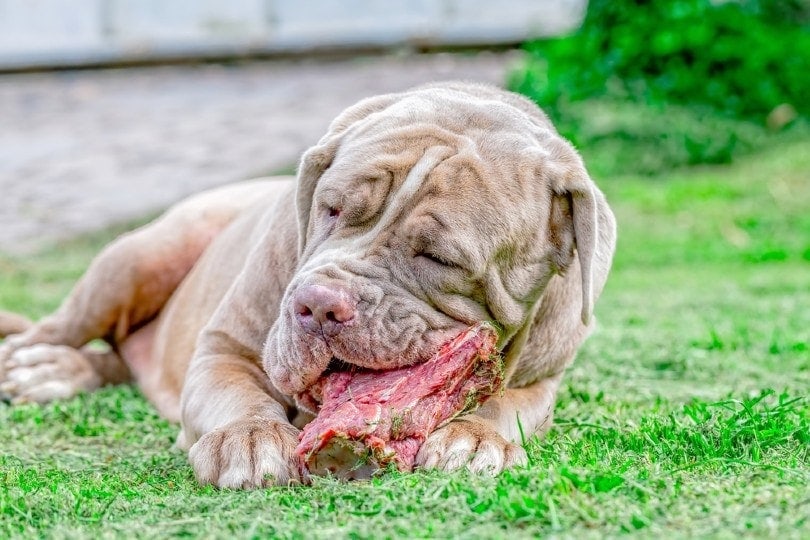
Diagnosis of Salmonella
Diagnosis of salmonella can prove to be difficult as signs are often non-existent, or if there are clinical signs, they are non-specific and generalized. Salmonella may be suspected based on history and clinical signs.
- Diet
- Travel history
- Recent health problems
- Contact with other sick animals or humans
- Recent stress on the immune system
Once the history has been taken, and your dog has been examined, your vet will carry out necessary tests. Routine blood work and urinalysis are usually carried out; this does not offer a definitive diagnosis but gives vital information about the red blood cell and white blood cell numbers and organ function. A definitive diagnosis is made by culture from feces. A blood culture may also need to be performed if sepsis is suspected or present.
Repeated fecal samples may be required to confirm the infection has gone. When testing, owners need to be aware that there is always a relatively high risk of false negative results. This is because salmonella can be excreted intermittently, especially in the end stages of the infection so caution must always be taken.
Other gastrointestinal issues causing inflammation of the intestines can cause very similar signs of salmonella infection. These include:
- Addison’s disease
- Gastrointestinal viruses
- Foreign body ingestion
- Parasites
Treatment of Salmonella in Dogs
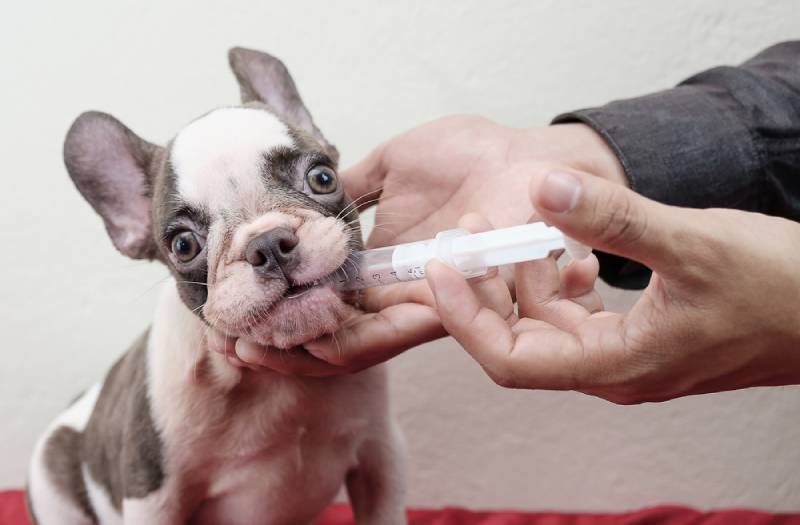
Treatment of salmonella in dogs does depend on the severity of the infection. Some dogs will require no treatment and the infection will run its course naturally. Some will receive no treatment as they will not show any clinical signs, so owners won’t be aware.
Mild cases of salmonella can be dealt with at home by the owner. The focus is on ensuring the dog receives adequate hydration to compensate for the fluid they are losing through vomiting and diarrhea. If your dog is not eating for a prolonged period of time you will need to take them to your vet.
Some dogs will require supportive treatment, mainly centered around treating gastrointestinal inflammation. This can include:
- Intravenous fluids therapy
- Anti-emetic drugs to control nausea and vomiting
- Antibiotics to get rid of the bacteria, and/or prevent the spread to the blood or other areas
- Drugs to reduce fever
- Feeding tubes if the dog is off food or unable to eat
- Probiotics to re-establish normal gut bacteria
More severe cases may require hospitalization of your dog. Intravenous fluids, intravenous antibiotics, and potentially blood transfusions may be necessary.
Recovery after Salmonella Infection
Most dogs without any underlying health issues will recover well in a few days. The prognosis is usually good unless there are other health complications or if sepsis has occurred. Once your dog is home from the vet, ensure that they always have access to fresh clean water throughout the day and the night. Feed them a bland simple diet for the first few days as they slowly get used to eating again. Boiled chicken and plain rice is a good option, or you can buy specific dog food for sensitive stomachs. Feed them small amounts little and often until they are able to eat normally again.
Salmonella is a zoonotic disease which means it can be passed between humans and dogs. Good hygiene is incredibly important as your dog may still be shedding the bacteria in their feces. Always wear gloves when picking up after your dog. Wash your hands with hot water and soap after any contact with your dog or after handling food bowls or toys they may have chewed. Do not let your dog lick your face or hands. Don’t use the same sink for washing your dog’s bowl as you do for preparing human food or washing human dishes.
You may be required to attend your vets for checkups or provide fecal samples for testing to ensure the infection has gone.
Frequently Asked Questions
How long does it take for salmonella to affect dogs?
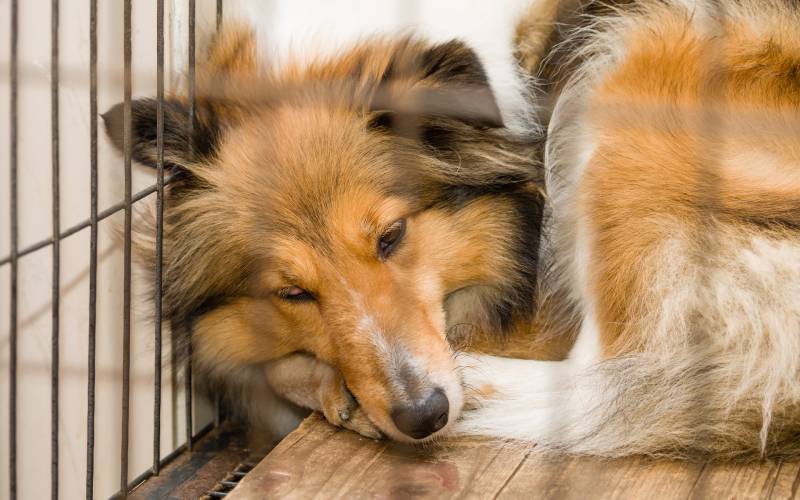
Dogs that have been exposed to salmonella usually display symptoms within the first 3 days after exposure. Some dogs won’t show any signs at all. If your dog is immunosuppressed or vulnerable in any way, they are more likely to show clinical signs sooner than fit, healthy dogs with no health issues.
Is salmonella serious in dogs?
Clinical illness from salmonella is normally rare in dogs, however, the risk is greatly increased if owners feed their dogs a raw food diet. Salmonella can cause severe disease in some dogs especially if sepsis develops. It can result in death if left untreated.
Can dogs fight off salmonella on their own?
Usually, dogs are able to fend off an infection without any clinical signs developing. Some infections are more severe than others and, in these cases, your dog will require veterinary attention. Intravenous fluids, antibiotics, and other supportive treatments may be utilized.
Conclusion
Salmonella is a common gastrointestinal bacterial infection. Clinical signs in dogs can be very variable. Mild cases usually recover in a few days with supportive care. Dogs that have severe diseases often require prolonged treatment and hospitalization. Dogs shed the bacteria in their feces for long periods after infection, so it is important that strict hygiene measures are put in place when dealing with a dog with salmonella. Feeding a raw diet increases the chance of your dog getting salmonella, the risks should be carefully thought through before starting a raw diet.
Featured Image Credit: Jumpstory





